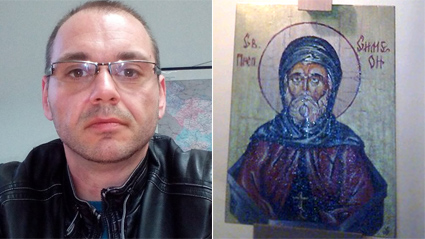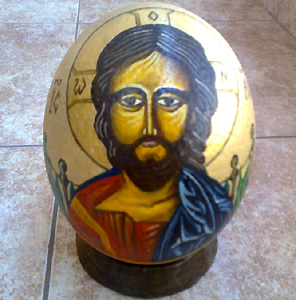 3
3
Bulgarian journalist Valeri Velikov joined Radio Varna right after he graduated from a fine arts school. Icon painting, however, remained his favorite hobby. Why he chose to paint icons? Here is what he told Radio Bulgaria.
“The answer to this question is very difficult, because my interest towards icons was born quite naturally. I am a nervous person and icon painting helps me calm down. That is why I started to paint icons. At one point, however, when I saw that things started to happen the right way, I decided that it was about time to move to another, semiprofessional level.”
Once, icon painters started their job only after a special training course. These people fasted for 40 whole days, prepared their paints of minerals and other natural materials, selected and prepared the base of their icons, which is usually a linden board covered with natural glue made of animal bones. They also used tempera paints mixed with egg yolk, which helped them preserve the brightest colors.
“With regard to the colors of the clothes, the positions of the saints' bodies, the gestures and the background images, I try to adhere to the cannon”, Valeri explains. “However, being a contemporary icon painter, just like many other colleagues, I also deviate slightly from the canon.”
“I also use oil paints and the effect is similar to tempera painting”, Valeri goes on to say. “Besides, I do not varnish my icons, because they look tacky, just like the works of some other modern icon painters. Gold-plating is one of the most difficult jobs in icon painting. Icon painters can use real gold, yet only the biggest professionals in this field do it. We can also use fake gold, which is the most common practice. Sometimes I use another material- high -quality gold paint.”
Icon painters used boards, as well as some non-traditional materials. For instance, in the 10th century people used to make ceramic icons of various saints and angels. Some of these icons had an oval shape. What was the most-interesting material in Valeri's career as an icon painter?
 “The most interesting material I ever painted on was an ostrich egg. However, it is not that strange nowadays, because it is widely-used at present. Firstly, I isolated its surface with poly-vinyl-acetate glue (C200). This is a frequently-used technique, which does not allow the paint to be absorbed by the material. Thus, the density of the colors is well-preserved. Later I drew our Saviour Jesus Christ over the egg.”
“The most interesting material I ever painted on was an ostrich egg. However, it is not that strange nowadays, because it is widely-used at present. Firstly, I isolated its surface with poly-vinyl-acetate glue (C200). This is a frequently-used technique, which does not allow the paint to be absorbed by the material. Thus, the density of the colors is well-preserved. Later I drew our Saviour Jesus Christ over the egg.”
Do icon-painting and radio journalism have something in common?
“Challenge is what links these two professions. Sometimes, when we start working over an interview or reportage, we actually do not know the final result, although we have a clear idea of how a given interview or reportage must be made. The same rule applies to icon painting: I start with a certain idea, but at some point, when I get to the middle of the job, I decide that I do not like the way it is done and I start to paint another saint, or the same one, but in a different position. So, sometimes we need to improvise in these two seemingly incompatible jobs”, Valeri Velikov concludes.
English version: Kostadin Atanasov
Photos: private library
A Thracian temple from the 3rd century BC, unparalleled in Bulgaria, can turn 10 acres of Plovdiv's South region into an archaeological park. The site is located at the base of the Great Mound, which a team of the Plovdiv-based Regional Archaeological..
After the Liberation of Bulgaria from Ottoman rule, architects from Europe flocked to Sofia, which became the new Bulgarian capital city in 1879, to give it a modern look and functionality. In the end of the 19 th century the first..
Patriarch Daniil of Bulgaria sent a letter to Metropolitan Onufriy of Kyiv and All Ukraine (Moscow Patriarchate), the Bulgarian Patriarchate reported. The message reads: "Your Beatitude, on this date exactly 10 years ago, your solemn enthronement as..

+359 2 9336 661
